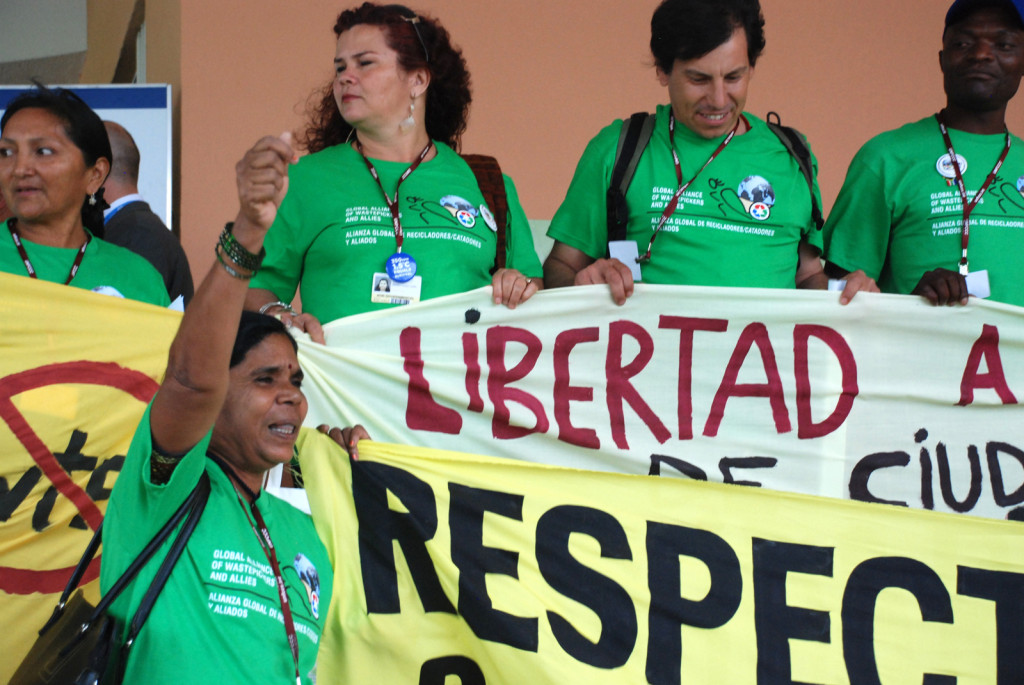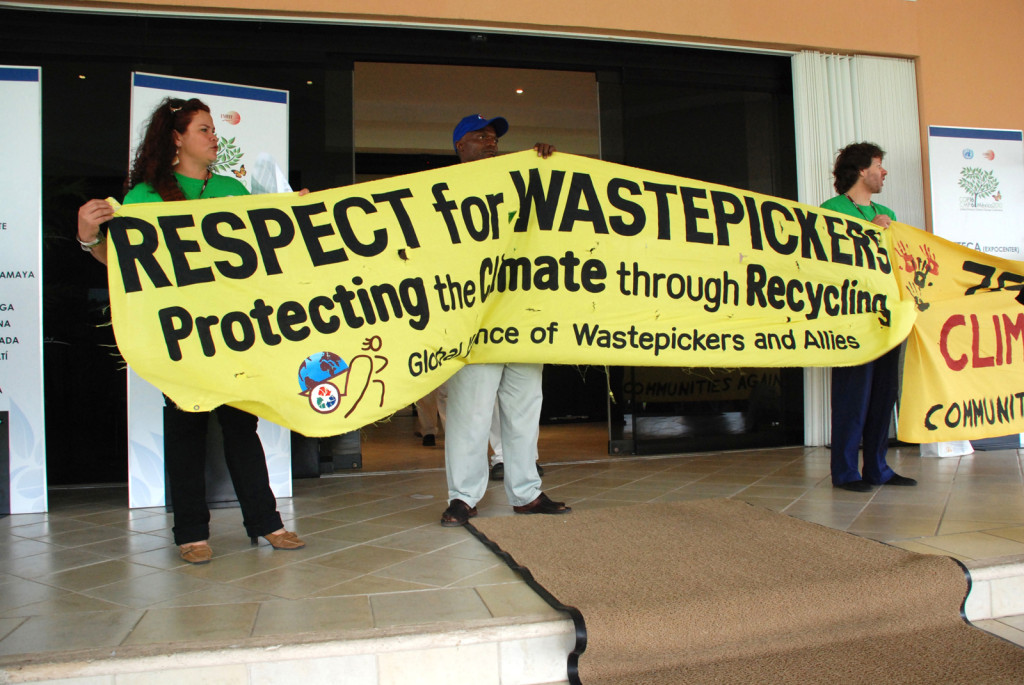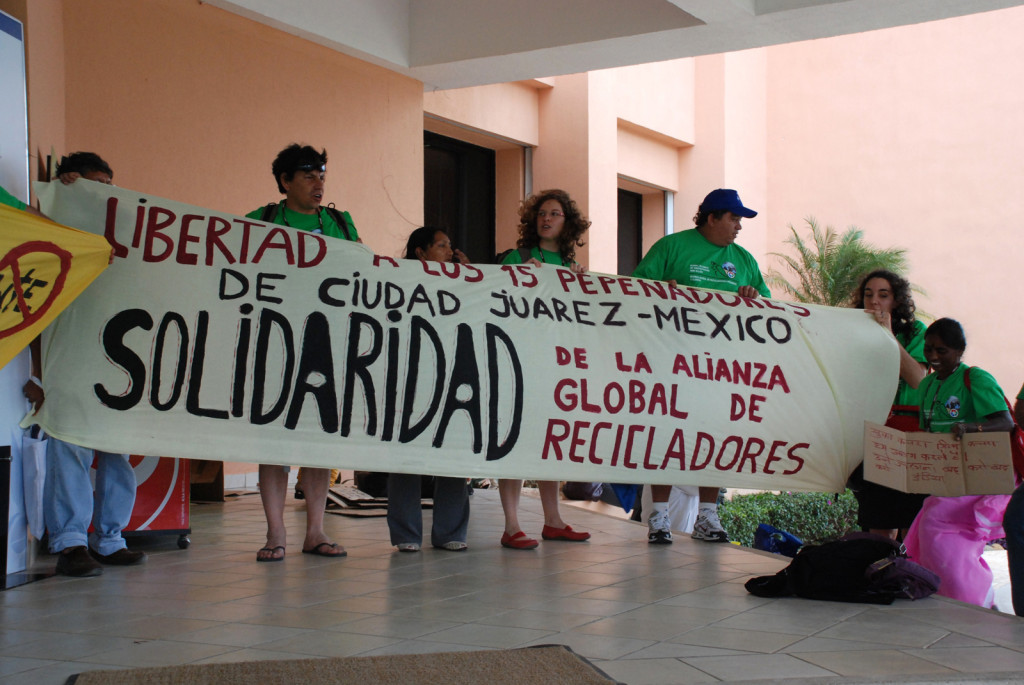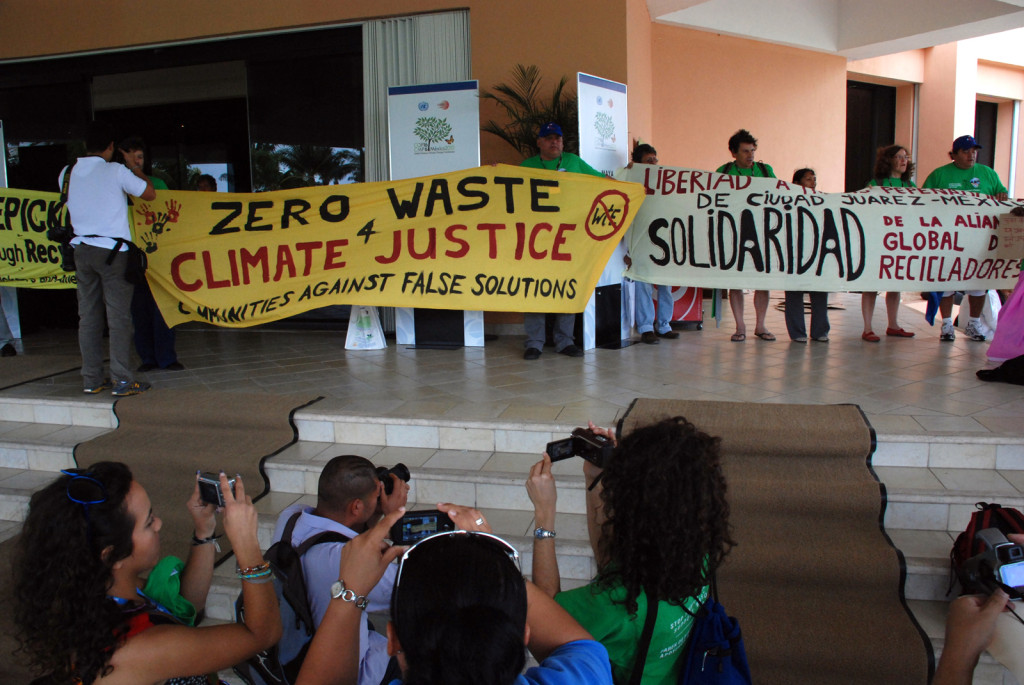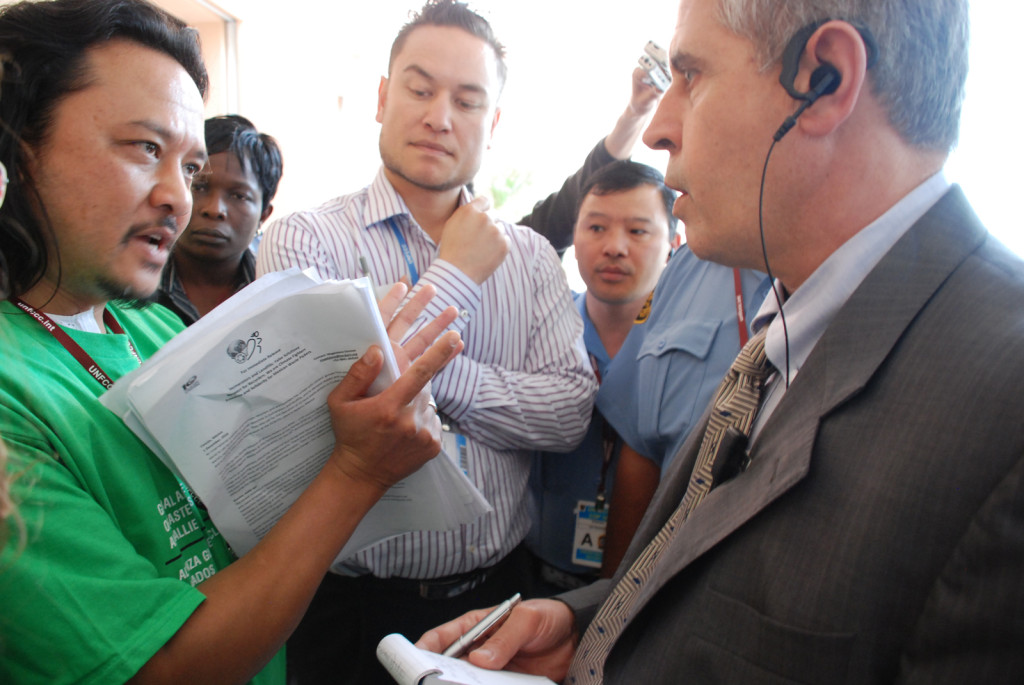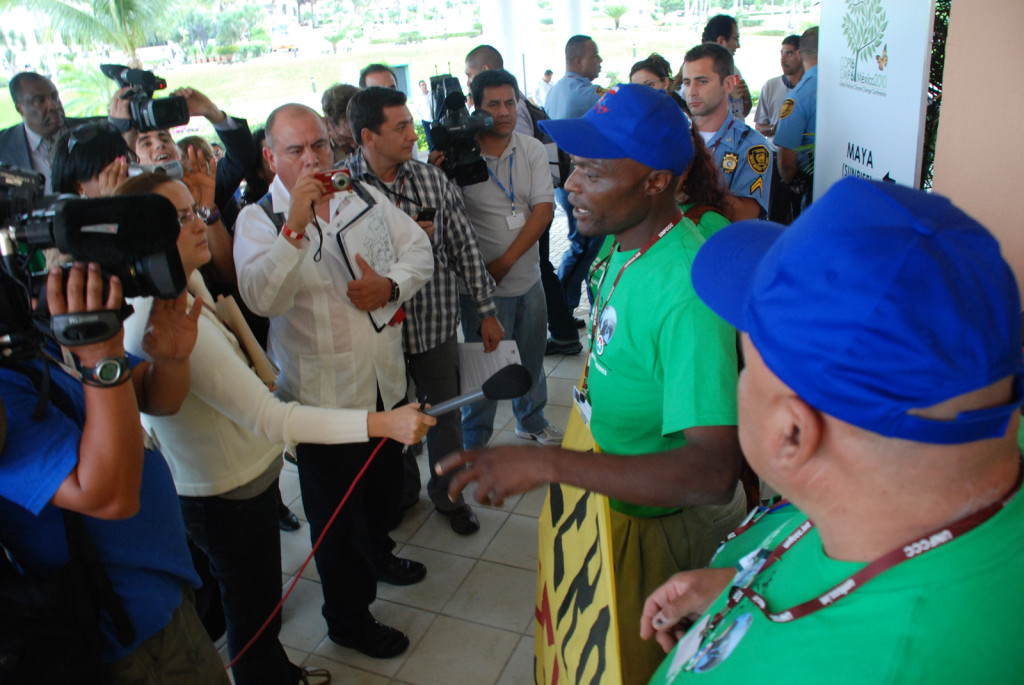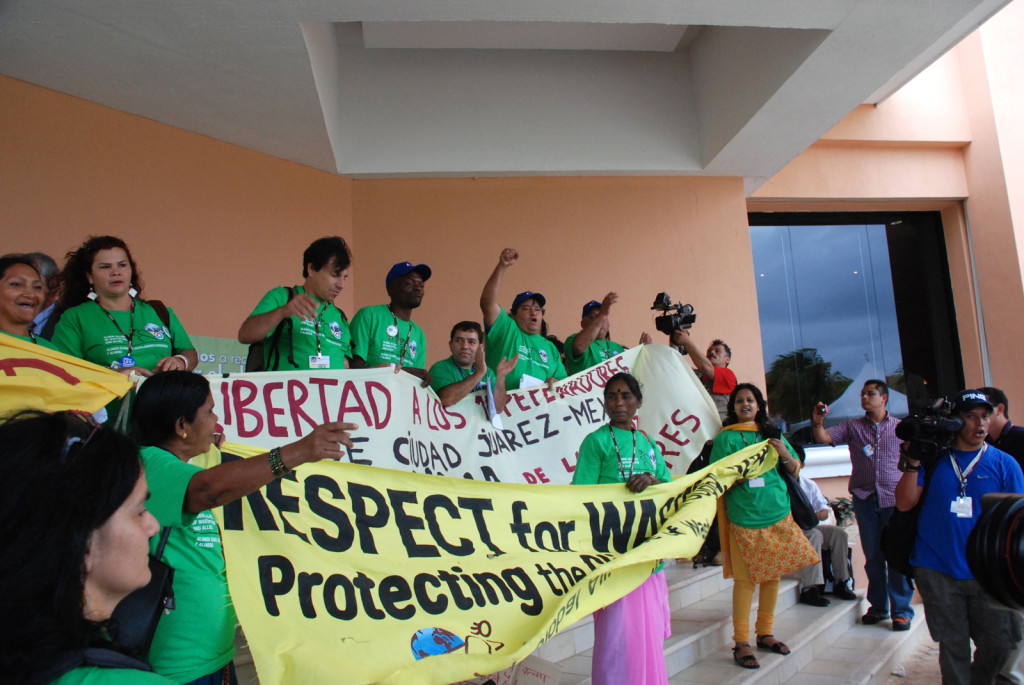Cross-posted from ClimateStoryTellers.org
By Subhankar Banerjee
29 November, 2010
The United Nations Framework Convention on Climate Change (UNFCC) COP16 opens this week in Cancún, Mexico to discuss green business (November 29 – December 10, 2010). No one is expecting any global climate treaty to be signed at this conference. However there is hope that some progress could be made.
Two articles in particular caught my attention over the weekend. The first article was published in Grist is by Jennifer Morgan, Climate Director at the World Resources Institute, a think tank based in Washington, DC. The title of her article is “What can climate negotiations achieve in Cancun?” She writes “Establish a REDD+ mechanism” in a section titled “What decisions can be made in Cancun?” What was striking for me was the title of the following section, “What other issues remain contentious?” Clearly REDD+ is not a contentious issue for Morgan. The second article was by Kate Sheppard titled “Cancun or Bust” published in Mother Jones. Her penultimate paragraph reads, “Despite the very low expectations for a major agreement, there are major areas where the observers expect to see progress this year: … the creation of programs to prevent deforestation (known as Reducing Emissions from Deforestation and Forest Degradation, or REDD). Progress in those areas would go a long way toward building trust and partnership between nations, observers say.”
I bet you’re wondering—what the heck is REDD?
Almost a year ago I went to Copenhagen for the last round of the UN Climate Conference COP15 with Sarah James, Gwich’in activist and current board chair of the Gwich’in Steering Committee in Fairbanks, Alaska. During the opening day of the conference Amy Goodman interviewed Sarah and I for a segment on Democracy Now. There, I participated in a contemporary art exhibition ‘(Re–) Cycles of Paradise’ organized by ARTPORT in partnership with Global Gender and Climate Alliance, where I presented a photo–video installation to highlight Sarah James’ work. That exhibition is currently being shown at the Centro Cultural de España in Mexico City through January 16 (will overlap with COP16 in Cancún).
While in Copenhagen, we stayed at a small hotel where each day we would gather at the lobby with other fellow indigenous activists including musician Robby Romero and his daughter, singer Dakota René of the Eagle Thunder Entertainment. Robby asked me have you heard about REDD? He told me a whole bunch of things about it but with all the commotion of the conference I came back with little understanding of what REDD actually is, except that the indigenous communities around the world regard it as the “largest land grab of all time.” While the conference resulted in failure, it gave birth to what has come to be known as the Climate Justice Movement.
So here is REDD from two different perspectives.
REDD According to the United Nations
Reducing Emissions from Deforestation and forest Degradation
REDD is a program that was conceived by the United Nations and launched in September 2008 with expertise of UN Food and Agriculture Organization (UNFAO), UN Development Programme (UNDP) and UN Environment Programme (UNEP).
According to UN–REDD website: “Deforestation and forest degradation, through agricultural expansion, conversion to pastureland, infrastructure development, destructive logging, fires etc., account for nearly 20% of global greenhouse gas emissions, more than the entire global transportation sector and second only to the energy sector.” The webpage continues, “(REDD) is an effort to create a financial value for the carbon stored in forests, offering incentives for developing countries to reduce emissions from forested lands and invest in low-carbon paths to sustainable development. REDD+ goes beyond deforestation and forest degradation, and includes the role of conservation, sustainable management of forests and enhancement of forest carbon stocks.”
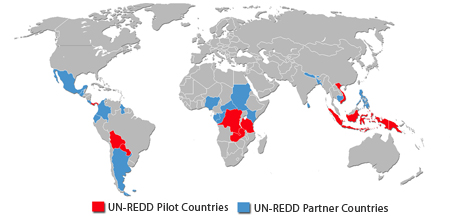
Map Courtesy UN-REDD Programme
UN website also states, “The Programme currently has 29 partner countries spanning Africa, Asia–Pacific and Latin America, of which 12 are receiving support to National Programme activities.”
Let me explain in simple terms what it means. You may have noticed in the UN description, the line, “to create a financial value for the carbon stored in forests.” Whenever there is value there is money that can be exchanged. Say a company in Global North, take BP for example want to continue their carbon emissions, but they want to offset it to reduce their net carbon footprint, then they can buy carbon credit through REDD, in the process some forest in Global South say, Indonesia would be saved while BP continues business–as–usual.
What could be wrong with such a well meaning and benign scenario to save the planet from climate change disasters?
On November 25 UN–REDD Program released a Newsletter with success stories and plans for the Cancún conference that you can check out here.
REDD According to the Indigenous Forest Communities
Reaping profits from Evictions, land grabs, Deforestation and Destruction of biodiversity
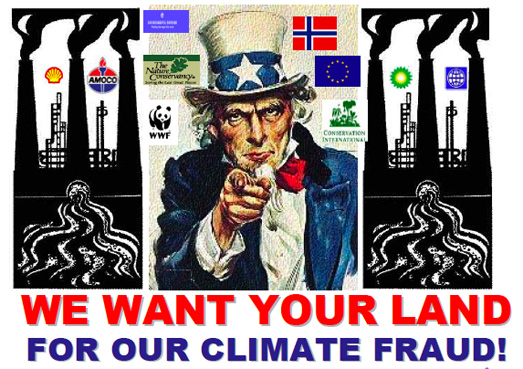
Illustration Courtesy Indigenous Environmental Network
On November 26 Global Forest Coalition and Indigenous Environmental Network (IEN) issued a joint press release. It states, “Indigenous and environmental rights groups warn that an agreement on REDD at the upcoming UN climate change conference in Cancún, Mexico will spell disaster for forest peoples worldwide, limiting the rights of indigenous and peasant people over their territories. The real solution, the groups argue, is for developed countries to reduce fossil fuel emissions at the source.”
Tom Goldtooth, Executive Director of IEN said, “Yes we need to stop rampant deforestation—but REDD will neither protect forests nor reduce dangerous pollution. REDD will allow polluting industries to avoid reducing emissions through offsets from trees and other so–called ‘environmental services.’ From an indigenous and human rights perspective, REDD could criminalize the very peoples who protect and rely on forests for their livelihood, with no guarantees for enforceable safeguards. REDD is promoting what could be the biggest land grab of all time.”
IEN with endorsements from numerous human rights and environmental justice organizations published a detailed 40–page report [pdf] explaining every aspects of the REDD and REDD+ initiatives. The report is filled with references as well as illustrations and photos. I’ll quote a few key points from that report, but I’ll not be able to do justice to such a detailed report with just a few hundred words here. My hope is that perhaps you’ll be curious to read the full report when you have time.
REDD and Permits to Pollute
“Carbon Markets buy and sell permits to pollute called allowances and carbon credits. Carbon markets have two parts: emissions trading (also called cap and trade) and offsets. They are false solutions to climate change because they do not bring about the changes needed to keep fossil fuels in the ground. They claim to solve the climate crisis but really allow polluters to buy their way out of reducing their emissions.”
REDD is CO2lonialism of Forests
“It allows Northern polluters to buy permits to pollute or carbon credits by promising not to cut down forests and plantations in the South. There are hundreds of REDD–type pilot projects in the world and, many of them violate Indigenous Peoples’ rights and have resulted in militarization, evictions, fraud, disputes, conflicts, corruption, coercion, conmen, crime, plantations, and 30–100 year contracts and deals with oil companies and other climate criminals.”
REDD Means Loss of Land and Evictions
“REDD could drive land speculation and result in massive land grabs in the name of saving the climate. It could result in violations of the UN Declaration on the Rights of Indigenous Peoples. In fact UN admits that REDD could: criminalize indigenous agriculture and lifestyles, violate indigenous peoples’ rights, lock–up forests and marginalize the landless.”
Scientific American reported last year, “Interpol has warned that unscrupulous entities plan to profit from REDD: their methods could include expelling an indigenous people from their forest to acquire legal title over it.”
“UNEP funded Mau Carbon Forest Project in Kenya is a humanitarian crisis in the making. Due to this project more than 20,000 Ogiek people face eviction from their ancestral land. Kenyan Prime Minister Raila Odinga announced that every single Ogiek would be facing arrest if they did not voluntarily abandon their ancestral lands in the Mau Forest region of Kenya—where the Ogiek have lived for centuries. Ogiek could become REDD refugees but they have vowed to resist any move to evict them.”
REDD and Militarization
“REDD could foster a ‘armed protection’ mentality that could lead to the displacement of millions of forest–dependent people, including by force: armed guards for pilot projects, remote sensors in forests and satellite surveillance of forests.”
Interpol has stated, “If there are indigenous people involved, there’s threats and violence against those people.” This is already happening. Abelie Wape, an Indigenous leader from Kamula Doso in Papua New Guinea, was forced at gunpoint to sign away the carbon rights to the forest. Kamula Doso is one of the most controversial of the REDD projects currently being set up anywhere in the world.
REDD and Oil Companies
An IEN press release ‘Shell bankrolls REDD’ states, “Oil giant Shell, infamous for the genocide of the Ogoni People and environmental destruction in Nigeria’s Niger Delta is now bankrolling REDD.” Renowned Nigerian environmentalist Nnimmo Bassey, Director of Environmental Rights Action and Chair of Friends of the Earth International, wrote, “We have suffered Shell’s destruction of communities and biodiversity as well as oil spills and illegal gas flaring for decades. Now we can add financing REDD for greenwash and profits to the long list of Shell’s atrocities.”
“Shell, Gazprom (Russian oil–and–gas giant) and the Clinton Foundation are funding the landmark REDD Rimba Raya project on 100,000 ha (250,000 acres) in the province of Central Kalimantan in Indonesia. REDD allows polluters like Shell, Rio Tinto and Chevron–Texaco to buy their way out of reducing their greenhouse gas emissions at source by supposedly conserving forests.”
In case you missed, Shell is also right now pressuring the Obama administration to give them the permit to go drill in the Beaufort and Chukchi Seas of Arctic Alaska that the Inupiat indigenous communities oppose as they fear it’ll destroy their homeland and culture.
REDD and GMO Trees
“The UNFCCC allows GMO trees to be used to generate carbon credits. Genetically Modified Trees are trees whose genetic material has been modified in a laboratory for rapid growth or to make it easier to produce agrofuels from wood. Trees are also genetically modified to increase pollution absorption and consequently to sell more permits to pollute. GMO Trees are very dangerous because they can contaminate natural forests just like GMO corn has contaminated natural corn.”
REDD and Conservation NGOs
REDD has controversial support from many powerful U.S. conservation NGOs including, World Wildlife Fund, The Nature Conservancy, Conservational International, Environmental Defense, National Wildlife Federation, Sierra Club, Natural Resources Defense Council, Wildlife Conservation Society and others.
Not the First Time—Conservation, Forced Eviction and Militarization
Historian Karl Jacoby of Brown University wrote an influential book a few years ago titled, “Crimes Against Nature: Squatters, Poachers, Thieves and the Hidden History of American Conservation.” In the book Jacoby writes about the dark history of American conservation and that during the mid and late 19th century how conservation of lands criminalized inhabitants. In a short order, ‘land dwellers’ were labeled ‘squatters’; ‘hunters’ to ‘poachers’; and ‘gatherers’ to ‘thieves.’
In one chapter Jacoby writes about the formation of the first National Park—the Yellowstone National Park. Euro–American conservationists told the American public that areas of the Yellowstone plateau had never been trodden by human footsteps. Quite the contrary—in reality five tribes, Crow, Shoshone, Bannock, Blackfeet, and Nez Perce actively hunted in the Yellowstone plateau. Yellowstone National Park was established in 1872. U.S. Military was brought in to run the park. In fact few Americans may know that the U.S. military ran the Yellowstone National Park for 32 years. Prominent conservationists of the time including the influential John Muir, founder of the Sierra Club supported the militarization of the U.S. public lands. Their job was to protect vulnerable tourists from the threat of dangerous Native Americans. In the process they protected the land by taking it away from the ‘people of the land.’
Trust–and–Partnership: A Seat at the Table?

During UNFCC Convention in Bali indigenous people protested the fact that they were shut out from the negotiations even though it is their land that UN was considering for carbon offsets | Courtesy Global Justice Ecology Project
I’ll now return to Kate Sheppard’s statement about “building trust and partnership between nations.” To build trust we must first talk—maybe we sit around in a circle and tell stories, or we sit around at a table and tell stories. Did UN give the indigenous peoples a sit at the table about REDD?
In an article published earlier this year in the Indian Country Today, Tom Goldtooth writes about his experience of Copenhagen where he went with a delegation of 12 Native people from U.S. and Canada, “Maintaining indigenous peoples’ participation inside the Bella Center was very important during the waning hours of the conference to ensure the rights of indigenous peoples would be recognized in the Accord (Copenhagen Accord). This did not happen. Neither human rights language nor the rights of indigenous peoples were recognized in the Accord.”
Earlier this year UN released a 222–page report tilted, “State of the World’s Indigenous Peoples.” The report states, “Millions of people around the world who belong to indigenous communities continue to face discrimination and abuse at the hands of authorities and private business concerns.” Inter Press Service reporting on the release stated, “The report’s chapter dealing with environmental issues suggests that most of the deforestation is taking place on indigenous territories due to massive operations by mining corporations. It says many of the business ventures on native lands are illegal.”
Euro–American conservationists protected vulnerable tourists by evicting the Native Americans nearly a century and half ago from the Yellowstone plateau. The question now arises—will the UN and influential conservation NGOs repeat the same episode but at a much larger global scale—by evicting the ‘people of the land’ to protect vulnerable kingdoms—BPdom, Shelldom, Exxondom, Americadom? Is Global North attempting to impose an order on the Global South, but for whose benefit?
We’ve just come to know for whose benefit. On Sunday Guardian reported “Some of the world’s largest oil, mining, car and gas corporations will make hundreds of millions of dollars from a UN-backed forest protection scheme (REDD), according to a new report from the Friends of the Earth International.”
I’ve worked on Arctic Alaska issues for nearly a decade. I see conservation and human rights organizations have been working hand–in–hand and shoulder–to–shoulder to achieve a common vision of conservation that honors both ecological and indigenous human cultures against destructive oil and gas development projects. So why is there such an unfathomable gap between the conservation and the indigenous communities about REDD? Is it because industrialized and industrializing nations will not significantly reduce their carbon emissions, fossil fuel companies will continue with business–as–usual with drilling and mining in more dangerous territories, and we will not reduce our carbon footprint to anything meaningful—so taking away the last remaining forests from the indigenous dwellers and giving the credits back to the polluters is the most expedient and the easiest road we can take to tackle climate change? Or by supporting REDD the conservation organizations will gain valuable dollars from the polluters for important conservation work or the worst of all they could care less about the indigenous communities of the Global South? How would anyone who is supporting REDD feel if they’re evicted from their home—actually it’s been happening a lot in U.S. with the real–estate collapse and no one likes it. So why would we support REDD?
Forests are dying all over the world at an unprecedented rate due to climate change—hundreds of millions of trees are dead—I wrote about it this summer. This is causing a lot of stress to the indigenous communities. Is this the time to tinker with trading carbons by taking away the forests from the indigenous inhabitants and then selling the credits to the polluters—or is it possible to develop a common global vision of moving away from fossil fuel altogether and working with forest dwellers on sustainable solutions? It is a moral question that we must answer. And that I’d call trust–and–partnership.
Here are some last words from Tom Goldtooth: “Everyone who cares about our future, forests, Indigenous Peoples and human rights should reject REDD because it is irremediably flawed, cannot be fixed and because, despite efforts to develop safeguards for its implementation, REDD will always be potentially genocidal.”
Copyright 2010 Subhankar Banerjee

